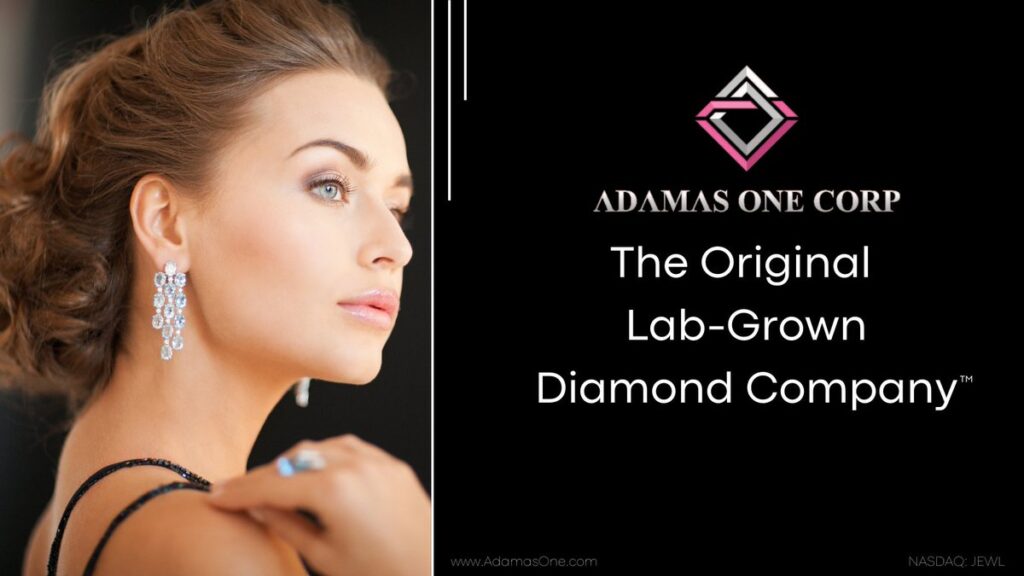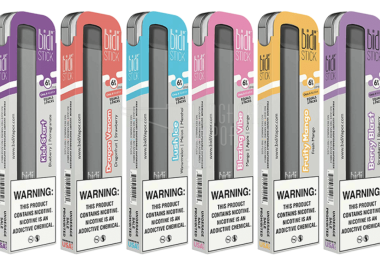Diamonds were once said to be every girl’s best friend, but consumer trends indicate this sentiment has lost its luster. Buyers have become more aware of the negative impacts of mining these shiny stones on the environment and the often exploitative treatment of those who work in them.
While the majority of those surveyed say they still appreciate the beauty of a diamond, they’d only be willing to purchase ones that have been sourced ethically. Of course, because diamonds come from deep within the earth, delivering under the terms of that high bar can be difficult- at least, it used to be. The diamond-producing landscape has since changed, allowing the right companies to make millions, potentially billions, of dollars from producing chemically identical diamonds and selling them at a significant discount to the cost of traditionally mined stones.
One of the leading lab-grown diamond companies is the US-based Adamas One Corp. (NasdaqCM: JEWL), a lab-grown diamond company leveraging revolutionary new technologies to produce extremely high-quality lab-grown diamonds for jewelry and industrial applications. Adamas’ patented technology helps it separate its diamonds’ quality and integrity from the competition.
Ethical Diamonds Are Everybody’s Best Friend
The better news for JEWL is that diamonds are more than a girl’s best friend; virtually everybody loves them. And why not – their sparkle, glitter, and shine enhance just about everything they’re coupled with. However, while many consumers may think of jewelry when they hear the word “diamond,” these precious gemstones aren’t only valued for their beauty. Diamonds have many applications outside of just for jewelry. Most people know that diamond is the hardest material known to mankind; therefore, its industrial applications for cutting, drilling, and medical sector use are superior to any other substance. Diamonds are also the most thermally conductive material on the earth. Targeting that opportunity, Adamas is developing lab-grown diamonds as thermal conductors for semiconductors, a significant contribution to building the semiconductor.
Each of these markets presents considerable revenue-generating opportunities beyond the jewelry sector. This is excellent news for companies like JEWL that can make diamonds to order by size and shape since it provides JEWL with other revenue-generating opportunities outside its jewelry-focused target market. In other words, targeting different needs can be more than a side hustle; they can be highly lucrative.
But here’s the best news of all, especially for those taking advantage of investing in JEWL stock at less than $1.00 a share: the company is already generating significant revenues, acquiring assets to facilitate stone-to-market capabilities, and has robust IP that could allow it to not only penetrate the lab-grown diamond market quicker than most; it can also protect its share.

Not Mined, Not Fake, Just Sped Up Perfection!
Let’s address the elephant hovering over your shoulder while you read this: lab-grown diamonds are not fake! Lab-grown diamonds are indeed 100% chemically, physically, and optically identical to mined diamonds. Even to the trained eyes of professional jewelers, lab-grown diamonds are visually and chemically indistinguishable from those mined from the earth.
As a matter of fact, on a comparative basis, lab-grown diamonds present virtually no drawbacks to their traditionally sourced counterparts. Knowing what goes into mining naturally-formed diamonds, the combined benefits offered by lab-grown diamond production become even more alluring. Adamas One certainly understands the benefits of being quick to market. It led them to turn ambitions into revenues, announcing they now have 12 full-capacity reactors growing diamonds at approximately 3,000 rough carats of diamonds a month. That production rate is expected to fuel revenue growth in 2023, with JEWL forecasting to post over $12 million in annual sales from its Greenville, South Carolina factory.
Remember, this ramp-up in production to full capacity is an initial phase of company development. Additional phases are planned to put more reactors into service by 2024 – possibly sooner – to capitalize on demand from a waiting market wanting high-quality lab-grown diamonds. Thus, the $12 million expected is the likely precursor of significantly higher totals. In fact, given the soaring demand for the types of diamonds JEWL produces, that’s more than possible; it’s probable.
Adamas One Positions to Serve Soaring Demand
Lab-grown diamonds represent over 50% of all loose diamond sales in the US! In 2022, the market for lab-grown diamonds was a $22.45 billion revenue-generating opportunity. But that figure is already dated; in 2023 and over the next five years, the market opportunity is expected to surge to $37.32 billion. While substantial and a built-in value driver for JEWL, that forecast may still be conservative given the shift in consumer preferences favoring products, including luxury jewelry, that are produced ethically and sustainably. Adamas One checks those boxes, which positions the company for expedited growth by leveraging an FTC ruling that opens the floodgates to new revenues.
In 2018, the FTC expanded its definition of diamonds, definitively recognizing lab-grown gems as equals to naturally mined stones. This ruling and validation created a tailwind for the forecast, leading expectations for the lab-grown diamond sector to grow at 9% CAGR into the decade’s end. Of course, being early to the market opportunity is excellent news for Adamas One. But what’s also important is that JEWL has already developed an IP arsenal that could keep competition to a minimum. Calling it robust may be an understatement, noting JEWL’s high-tech, proprietary, and scalable process to produce lab-grown diamonds is protected by 36 issued patents, with 28 of those in the United States covering sources and methods to create high-quality, single-crystal lab-grown diamonds for industrial and jewelry applications.
Not only does that IP protect JEWL’s assets, but it also sends revenues faster toward its bottom line. That’s evidenced by gross margins expected to be in the 70%+ range. EBITDA margins are also likely to be impressive, with JEWL forecasting 50%+ upon completing its planned expansions and integrating its anticipated acquisition of Flawless Allure Grown Diamonds, LLP. It’s simple math: the less JEWL sends out for finishing, the more significant the impact of revenues on EPS. Acquiring Flawless Allure can be a pivotal transaction, allowing JEWL to manage and keep the entire production to marketing ecosystem in-house.
Getting Bigger Faster with Flawless Allure
Not only will that deal’s closing be immediately accretive, but it will solidify JEWL’s position as a leader in the lab-grown diamond industry. They will be unique in their ability to facilitate end-to-end production, offering efficient production times and a quick time-to-market. As one of the industry’s top diamond cut and polishers, Flawless Allure (FAGD) will add significant value, which the company said will accrue with minimal dilution. If that’s the case, and with JEWL transforming into a self-sufficient production machine that can control stone production and turnaround time for cutting and polishing, current share prices may expose a valuation disconnect too wide to ignore.
After all, Adamas One gets a lot through the transaction. Upon closing, JEWL expects to acquire 100% of FAGD, including all patents, trademarks, know-how, trade secrets, supply lists, and other intellectual property assets. They would also take under its ownership all material assets, including property and property rights currently held by the soon-to-be acquired company. All told, the completed acquisition allows JEWL to exploit an enviable position and capability to control all aspects of producing its lab-grown diamonds. That’s a big deal.
Harnessing and effectively utilizing that power facilitates JEWL targeting diverse market demand, from consumer-grade to flawless to industrial. Even the most prominent players in the space should be paying attention to the property JEWL is building. That includes Anglo American ($NGLOY), LVMH Moet ($LVMUY), DeBeers, Gem Diamonds Ltd ($GMDMF), and Rio Tinto ($RIO), who for generations enjoyed relative scarcity in their competitive landscapes.
Not anymore, however, as lab-grown diamonds’ price point and physical advantages over traditional diamonds are two metrics disrupting the status quo. Additionally, consolidation by smaller players, exampled by JEWL intending to acquire Flawless Allure, can be a driving force to shift the balance of power in the sector. With the industry behemoths stuck doing things the old way, tearing up resources and exploiting labor, the changing of the sector guards could happen faster than many expect. Don’t rule out Adamas One being a leading force in that change.
Lab Grown Diamond Advantages are Many
After all, they have assembled the right pieces to lead the revolution. They are also proving by example that lab-grown diamonds bring several benefits in addition to the quality of the material. Compared to traditionally sourced gems, lab-grown diamonds offer cost, clarity, size, scale, and ethical production considerations, all of which are advantages. Moreover, while incorporating the best qualities diamonds can offer, lab-grown diamonds retail at about 35-45% less than mined diamonds.
As more consumers become more educated about lab-grown diamonds, their demand should rise accordingly, adding to the survey indicating that 57% of consumers would purchase a lab-grown diamond ring over the mined diamond alternative. Only 30% of consumers are committed to preferring the mined diamond, and the rest are unsure of their preference.
Education may change those perspectives, noting many consumers remain unaware of the diamond mining sector’s bloody history. However, more and more prospective customers are learning these facts and turning their attention to the new lab-grown products as a result. And given the grim realities that fuel the traditional diamond mining industry, that isn’t surprising.
Traditionally mined diamonds almost always necessitate that companies choose sides during violent conflicts, which often involve horrifying war crimes, the usage of child soldiers, slave labor, and mass killings in diamond-rich locations such as Sierra Leone. This is almost unavoidable for many traditional gem producers because of where and how diamonds have historically been mined. As this information becomes more widely known through social media channels, consumer preferences are rapidly shifting toward lab-grown alternatives. But that’s not the only ethical concern that has customers avoiding mined diamonds.
In addition to the human conflict surrounding the business, many diamond mines present substantial ecological effects that endanger entire ecosystems and contribute to a globally higher carbon footprint. These mines also play a role in destroying agricultural infrastructure, deforestation, and airborne and water pollution; they can also become breeding grounds for disease vector insects such as mosquitoes. From a societal and environmental standpoint, mining diamonds is nothing short of devastating.
Adamas One: Capitalizing on Opportunities in a Changing Diamond Sector
Combining the sum of JEWL’s parts totals a value lacking from its current share price. Worse, its market cap of roughly $14 million on Wednesday neglects a company whose growth trajectory is steepening even before its planned acquisition of Flawless Allure. By completing its production and marketing ecosystem, the value from that completed acquisition alone should dwarf the current market cap. Speculation should favor closing that deal.
But there’s plenty more than the inherent value of Flawless Allure to support a significantly higher share price. That includes Adamas One expecting to post $12 million for its fiscal year, holding valuable IP that can keep the competitive landscape thin, and advancing toward its next phase of development, which will add additional reactors to generate more diamonds.
Couple all that with JEWL enjoying high gross margins and equally impressive EBIDTA margins, at under $1.00, the disconnect between assets, IP strength, revenue growth, and its share price may be too significant to ignore. But, with JEWL positioned better than most in a multi-billion dollar sector, it’s equally timely to suggest that savvy investors wanting exposure to a booming industry through a fast-growing JEWL- aren’t.
Disclaimers: Hawk Point Media Group, Llc. (HPM) is responsible for the production and distribution of this content. Hawk Point Media Group, Llc. is not operated by a licensed broker, a dealer, or a registered investment adviser. It should be expressly understood that under no circumstances does any information published herein represent a recommendation to buy or sell a security. Our reports/releases are a commercial advertisement and are for general information purposes ONLY. We are engaged in the business of marketing and advertising companies for monetary compensation. Never invest in any stock featured on our site or emails unless you can afford to lose your entire investment. The information made available by Hawk Point Media Group, Llc. is not intended to be, nor does it constitute, investment advice or recommendations. The contributors do NOT buy and/or sell securities before, during, or after any feature report and publication. HPM holds ZERO shares and has never owned stock in Adamas One Corp. In no event shall Hawk Point Media Group, Llc. be liable to any member, guest or third party for any damages of any kind arising out of the use of any content or other material published or made available by Hawk Point Media Group, Llc., including, without limitation, any investment losses, lost profits, lost opportunity, special, incidental, indirect, consequential or punitive damages. Past performance is a poor indicator of future performance. The information in this video, article, and in its related newsletters, is not intended to be, nor does it constitute, investment advice or recommendations. Hawk Point Media Group, Llc. strongly urges you conduct a complete and independent investigation of the respective companies and consideration of all pertinent risks. Readers are advised to review SEC periodic reports: Forms 10-Q, 10K, Form 8-K, insider reports, Forms 3, 4, 5 Schedule 13D. For some content, HPM, its authors, contributors, or its agents, may be compensated for preparing research, video graphics, and editorial content. Hawk Point Media Group, LLC. has been compensated two-thousand-dollars cash via wire transfer from Trending Equities, Inc. to produce and syndicate content for Adamas One Corp. for a period of one week beginning on 11/22/23 and ending on 11/26/23. This compensation is a major conflict of interest in our ability to be unbiased regarding our alerts. Therefore, this communication should be viewed as a commercial advertisement only. Any non- compensated alerts are purely for the purpose of expanding our database for the benefit of our future financially compensated investor relations efforts. As part of all content, readers, subscribers, and website viewers, are expected to read the full disclaimers and financial disclosures statement that can be found on our website. Contributors reserve the right, but are not obligated to, submit articles for fact-checking prior to publication. Contributors are under no obligation to accept revisions when not factually supported. Furthermore, because contributors are compensated, readers and viewers of this content should always assume that content provided shows only the positive side of companies, and rarely, if ever, highlights the risks associated with investment. Thus, readers and viewers should accept the content as an advertorial that highlights only the best features of a company. Never take opinion, articles presented, or content provided as a sole reason to invest in any featured company. Investors must always perform their own due diligence prior to investing in any publicly traded company and understand the risks involved, including losing their entire investment. The Private Securities Litigation Reform Act of 1995 provides investors a safe harbor in regard to forward-looking statements. Any statements that express or involve discussions with respect to predictions, expectations, beliefs, plans, projections, objectives, goals, assumptions or future events or performance are not statements of historical fact may be forward looking statements. Forward looking statements are based on expectations, estimates, and projections at the time the statements are made that involve a number of risks and uncertainties which could cause actual results or events to differ materially from those presently anticipated. Forward looking statements in this action may be identified through use of words such as projects, foresee, expects, will, anticipates, estimates, believes, understands, or that by statements indicating certain actions & quote; may, could, or might occur. Understand there is no guarantee past performance will be indicative of future results. Investing in micro-cap and growth securities is highly speculative and carries an extremely high degree of risk. It is possible that an investors investment may be lost or impaired due to the speculative nature of the companies profiled.






